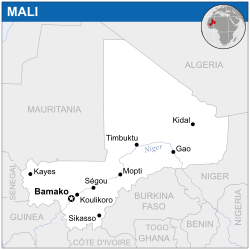Mali
| Republic of Mali | ||||||
|---|---|---|---|---|---|---|
| ||||||
| Motto: "Un peuple, un but, une foi" (French) "One nation, one goal, one faith" | ||||||
| Anthem: Le Mali (French)[1] | ||||||
|
Location of Mali (dark blue)
| ||||||
|
| ||||||
| Capital and largest city | Bamako 12°39′N 8°0′W | |||||
| Official languages | French | |||||
| Vernacular languages | Bambara | |||||
| Ethnic groups | ||||||
| Demonym | Malian | |||||
| Government | Unitary semi-presidentialrepublic | |||||
| • | President | Ibrahim Boubacar Keïta | ||||
| • | Prime Minister | Modibo Keita | ||||
| Legislature | National Assembly | |||||
| Independence | ||||||
| • | from Francea | 20 June 1960 | ||||
| • | as Mali | 22 September 1960 | ||||
| Area | ||||||
| • | Total | 1,240,192 km2(24th) 478,839 sq mi | ||||
| • | Water (%) | 1.6 | ||||
| Population | ||||||
| • | April 2009 census | 14,517,176[2] (67th) | ||||
| • | Density | 11.7/km2 (215th) 30.3/sq mi | ||||
| GDP (PPP) | 2012 estimate | |||||
| • | Total | $17.983 billion[3] | ||||
| • | Per capita | $1,100[3] | ||||
| GDP (nominal) | 2012 estimate | |||||
| • | Total | $10.319 billion[3] | ||||
| • | Per capita | $631[3] | ||||
| Gini (2010) | 33.0[4] medium | |||||
| HDI (2013) | low · 176th | |||||
| Currency | West African CFA franc (XOF) | |||||
| Time zone | GMT (UTC+0) | |||||
| • | Summer (DST) | not observed (UTC+0) | ||||
| Drives on the | right[6] | |||||
| Calling code | +223 | |||||
| ISO 3166 code | ML | |||||
| Internet TLD | .ml | |||||
| a. | As the Sudanese Republic, with Senegal as theMali Federation. | |||||
Mali ( i/ˈmɑːli/; French: [maˈli]), officially the Republic of Mali (French: République du Mali), is a landlocked country in West Africa. Mali is the eighth-largest country in Africa, with an area of just over 1,240,000 square kilometres (480,000 sq mi). The population of Mali is 14.5 million. Its capital is Bamako. Mali consists of eight regions and its borders on the north reach deep into the middle of theSahara Desert, while the country's southern part, where the majority of inhabitants live, features the Niger and Senegal rivers. The country's economy centers on agriculture and fishing. Some of Mali's prominent natural resources include gold, being the third largest producer of gold in the African continent,[7] and salt. About half the population lives below the international poverty line of $1.25 (U.S.) a day.[8] A majority of the population (55%) are non-denominational Muslims.[9]
i/ˈmɑːli/; French: [maˈli]), officially the Republic of Mali (French: République du Mali), is a landlocked country in West Africa. Mali is the eighth-largest country in Africa, with an area of just over 1,240,000 square kilometres (480,000 sq mi). The population of Mali is 14.5 million. Its capital is Bamako. Mali consists of eight regions and its borders on the north reach deep into the middle of theSahara Desert, while the country's southern part, where the majority of inhabitants live, features the Niger and Senegal rivers. The country's economy centers on agriculture and fishing. Some of Mali's prominent natural resources include gold, being the third largest producer of gold in the African continent,[7] and salt. About half the population lives below the international poverty line of $1.25 (U.S.) a day.[8] A majority of the population (55%) are non-denominational Muslims.[9]
Present-day Mali was once part of three West African empires that controlled trans-Saharan trade: the Ghana Empire, the Mali Empire (for which Mali is named), and the Songhai Empire. During its golden age, there was a flourishing of mathematics,astronomy, literature, and art.[10][11] At its peak in 1300, the Mali Empire covered an area about twice the size of modern-day France and stretched to the west coast of Africa.[12] In the late 19th century, during the Scramble for Africa, France seized control of Mali, making it a part of French Sudan. French Sudan (then known as the Sudanese Republic) joined with Senegal in 1959, achieving independence in 1960 as the Mali Federation. Shortly thereafter, following Senegal's withdrawal from the federation, the Sudanese Republic declared itself the independent Republic of Mali. After a long period of one-party rule, a coup in 1991 led to the writing of a new constitution and the establishment of Mali as a democratic, multi-party state. Significant portions of its legislation are derived from Islamic sharia law.
In January, 2012, an armed conflict broke out in northern Mali, which Tuareg rebels took control of by April and declared thesecession of a new state, Azawad.[13] The conflict was complicated by a military coup that took place in March[14] and later fighting between Tuareg and Islamist rebels. In response to Islamist territorial gains, the French military launched Opération Serval in January, 2013.[15] A month later, Malian and French forces recaptured most of the north. Presidential elections were held on 28 July 2013, with a second round run-off held on 11 August, and legislative elections were held on 24 November and 15 December 2013.





Aucun commentaire:
Enregistrer un commentaire